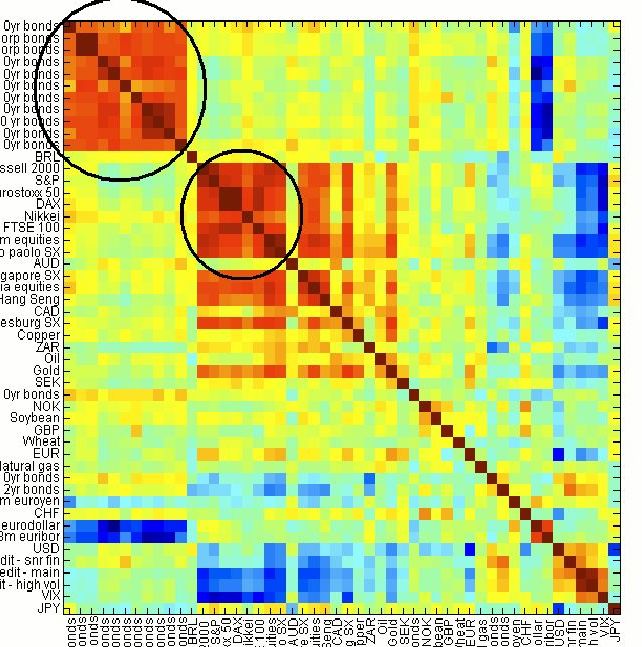by Rick Ferri
Correlation analysis in portfolio management design is overrated. There isn’t much benefit derived from relying on low correlation among asset classes to achieve excess return. The best way to use correlation is as a tool for determining unique risk within an asset class. After that, put it back in your toolbox.
According to the Merriam-Webster dictionary, correlation is the relationship between things that happen or change together. In investing, correlation is a measure that indicates the degree to which the prices of two assets move together relative to their means. The correlation between two stocks is 1.0 when the prices of the two stocks move completely in tandem to their average prices. It is -1.0 when they move opposite of each other relative to average price.
Measuring the correlation among two asset classes is typically done by taking the long-term monthly returns of one asset class and comparing them to another. This can be done in any spreadsheet program.
For example, from 1926 to 2013, the correlation between the US stock market and 5-year Treasury note monthly returns has been +0.07. That’s a very low correlation for two asset classes. It also means the two asset classes in a portfolio would work well together.
Unfortunately, long-term correlation isn’t the whole story because it misses what happens over different time periods. In fact, the correlation between the US stock market and 5-year Treasury note returns isn’t 0.07. Rather it only passes through that number on a rare occasion as it swings from positive correlation to negative and back again. Figure 1 illustrates this phenomenon using rolling 5-year correlations.
Figure 1: Rolling 5-year correlation between US stocks and 5-year Treasury note

Source: CRSP US total equity and 5-Year Treasury notes from the DFA Returns program. Correlation calculations by Rick Ferri.
The low overall correlation of these two asset classes has helped create a portfolio benefit for clients who rebalance each year. But we can’t say what the benefit will be. It depends on whether the correlation is negative or positive over the period. Unfortunately, there is little evidence that future correlation among asset classes can be predicted and past correlation is a poor estimate of future correlation.
Figure 2 shows the efficient frontier in two different periods using the US stocks and 5-year Treasury note example. The vertical axis (Y-axis) is annualized return and the horizontal axis (X-axis) is the annualized standard deviation of return.
Figure 2: The efficient frontier of US stocks and 5-year Treasuries over different periods

Source: CRSP US total equity and 5-Year Treasury notes from the DFA Returns program. Calculations by Rick Ferri.
The correlation between the two asset classes was about +0.3 during the 1970 to 1985 period. This resulted in a modest 50% stock and 50% bonds portfolio benefit of about 0.5% in extra return and perhaps a 2.0% reduction in risk. Not bad, but remember that is before trading costs and other investment fees.
During the 2002 to 2013 period, the correlation between the two asset classes was around -0.3. This resulted in an impressive portfolio benefit of about 1.7% in extra return and perhaps a 5.0% reduction in risk. It was a very unusual period that resulted in measureable excess returns from rebalancing.
My question is this, how should investors use this data to construct their portfolio?
Here is where I differ from the common wisdom. My view is that the correlation data is best used to confirm that stocks and 5-year T-notes are fundamentally different asset classes that have unique risks. That’s why the correlation between the two asset classes varies. After this conclusion, there isn’t much to say about future correlation except that the benefit of it will fluctuate. See my book, All About Asset Allocation, for a more detailed explanation.
Here is where I’m going with all this. I find that too many people are relying on correlation for alpha. They’re working in a higher expected return into their investment planning model because they believe that rebalancing among asset classes will result in a higher return and lower risk.
I don’t buy into that concept. Believing that rebalancing among asset classes will achieve an excess return is a mistake. It might happen, but don’t count on it.
My expectation of portfolio return does not include the hope of a rebalancing alpha. I simply average the asset classes’ returns together by weight to come up with the expected portfolio return. I don’t assume any alpha from low correlation that may be achieved from rebalancing.
Here’s a simple example. Assume the expected return of US stocks is 7% and the expected risk as measured by annualized standard deviation is 16%. Also assume the expected return of 5-year T-notes is 2% and the expected risk as measured by annualized standard deviation is 5%. My expected return on a portfolio 50/50 stock/bonds portfolio is 4.5% (7% + 2% / 2). The expected risk is 10.5% (16% + 5% / 2).
I realize that historically there has been a benefit to rebalancing; sometimes a large benefit. But those are hypothetical returns, not actual investor returns. I only care about what investors are likely to earn in the future.
In the real world, the excess return from rebalancing among two asset classes may not exist at all in the long term. Whatever benefit there is from the exercise likely gets eaten up by fees, commissions, trading costs, cash drag and poor portfolio maintenance. Why tell people they going to get an excess return when they’re not likely to get it?
Real-world investors should plan to receive a portfolio risk and return that doesn’t include a portfolio benefit from rebalancing among low correlated asset classes. In a sense, this means: plan for a +1.0 correlated world. We use 5-year Treasury notes to reduce the risk of all stocks, and that’s about it. If a benefit occurs, great!
This is a sensible way to approach the use of correlation in investing and asset allocation.
Copyright © Rick Ferri















